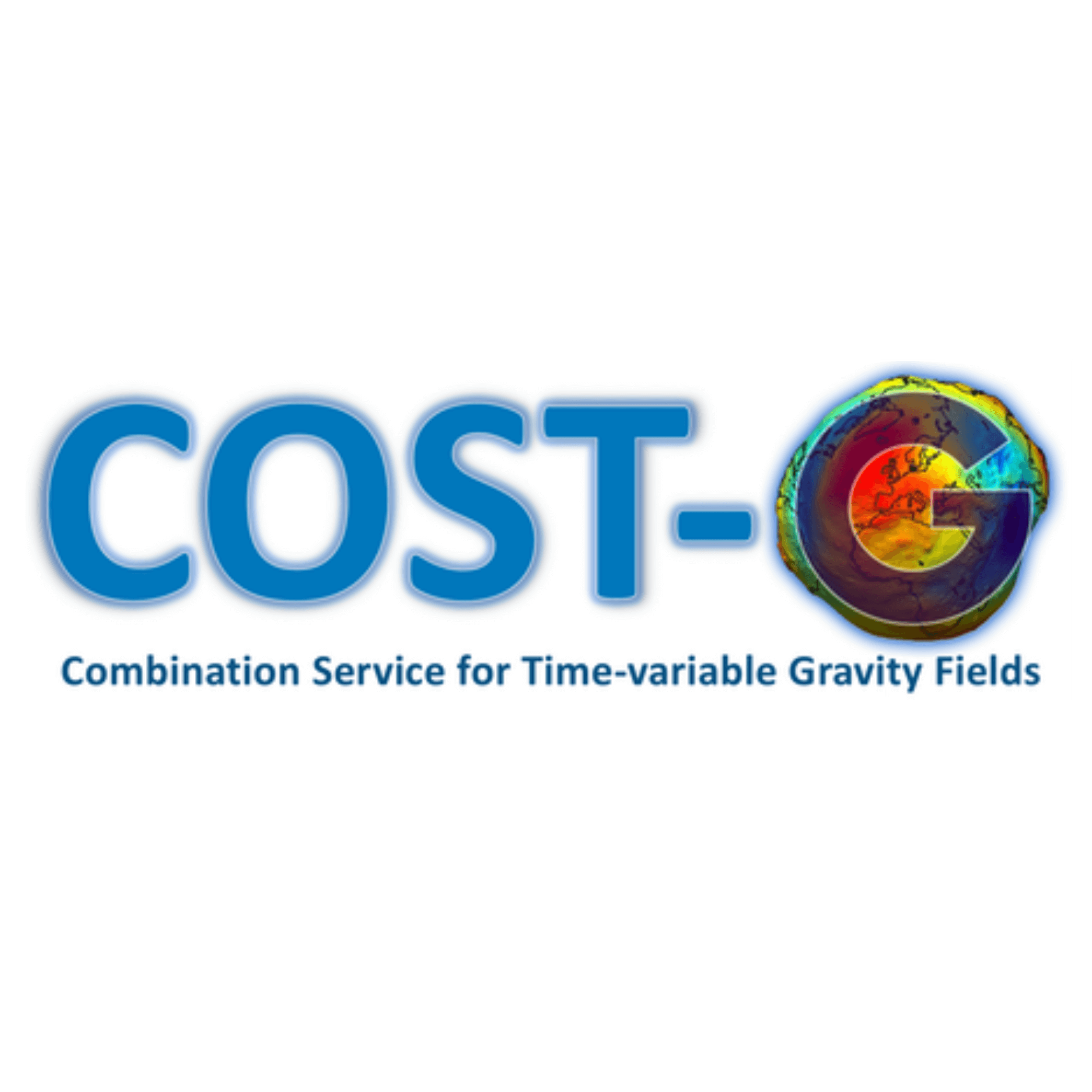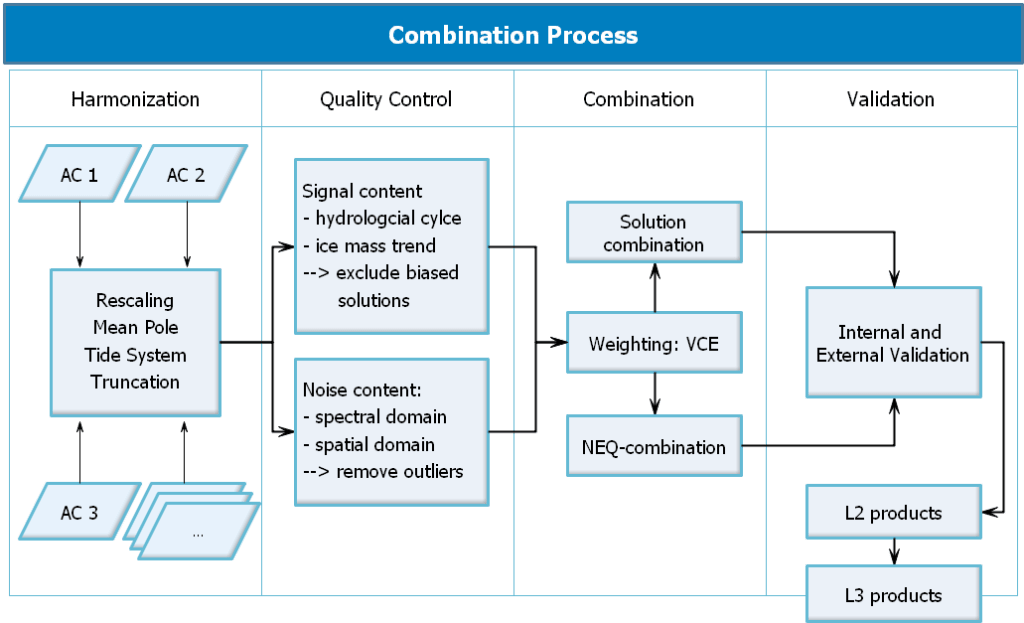COST-G
Combination Service for Time-Variable Gravity Fields
Overview
The International Combination Service for Time-variable Gravity Fields (COST-G) is the Product Center of the International Gravity Field Service (IGFS) for time-variable gravity fields. COST-G provides consolidated monthly global gravity models in terms of spherical harmonic (SH) coefficients and thereof derived grids by combining existing solutions or normal equations (NEQs) from COST-G analysis centers (ACs) and partner analysis centers (PCs).
The NASA/DLR GRACE satellite mission provided 15 years (2002-2017) of observations of the changing Earth masses in the Earth system, e.g. the ice masses in Greenland. Several analysis centers are engaged in the determination of these mass variations, many of them are Analysis or Partner Analysis Centers in COST-G. Its successor mission GRACE-FO, implemented and operated by NASA and the German Research Centre for Geosciences (GFZ), is now in space and continues to provide data of the same quality as GRACE.
Earth observation (EO) satellites yield a wealth of data for scientific, operational, and commercial exploitation. Observations, derived from the Gravity Recovery and Climate Experiment (GRACE) mission, and by GRACE-FO (Follow-on), deliver fundamental insights into the global water cycle, ice mass redistributions, ocean circulation and the solid Earth. For example, changes in continental water storage control the regional water budget and can, in extreme cases, result in floods and droughts that often claim a high toll on infrastructure, the economy and human lives.
Objectives
Due to different processing strategies, individual solutions of the analysis centers may differ in terms of mass variation. COST-G aims at consolidating these monthly global gravity models in terms of spherical harmonic coefficients (Level 2) and derived grids (Level 3) by combining the solutions of the individual centers.
The COST-G ACs adopt different analysis methods but apply agreed-upon consistent processing standards to deliver time-variable gravity field models, e.g. from GRACE/GRACE-FO low-low satellite-to-satellite tracking (ll-SST), high-low satellite-to-satellite tracking (hl-SST) such as for ESA’s Swarm mission, Satellite Laser Ranging (SLR).
COST-G recognizes and emphasizes the existence and acknowledges the contribution of every individual AC and PC. Their participation is a crucial and mandatory prerequisite to the consolidation of monthly global gravity fields within COST-G.
COST-G performs a quality control of the individual contributions before combination. COST-G provides:
- Combined gravity field solutions in SH coefficients (Level-2 products) derived from a weighted combination of individual contributions generated by the different ACs,
- Spatial grids and other high-level products (Level-3 products) of the Combined Solutions for hydrological, oceanic, and polar ice sheets applications.
Services
COST-G combines the gravity field solutions of various analysis centers (ACs). Currently, solutions are provided for GRACE, GRACE-FO and Swarm. The combination procedure consists of four major steps:
- Harmonization: the various solutions are transformed to a common system
- Quality control: the signal content as well as the noise content is evaluated in order to eliminate biased solutions and/or outliers.
- Combination is performed on two levels:
- Solution level, i.e. the spherical harmonic coefficients are combined using variance component estimation (VCE); details can be found in Jean et al. (2018)
- Normal-EQuation-level (NEQ), i.e. the normal equations of the analysis centers are combined; details can be found in Meyer et al. (2019)
- Internal and external validation ensure the quality of the product
Evaluation of Models
Evaluation of the models is performed in a two-stage process by the validation center and the product evaluation group.
Validation Centers focus on a noise assessment of the derived solutions. Tasks of the VC include:
- Evaluation of the noise of the solutions over dedicated areas of low variability
- Evaluation of the quality of the solutions through comparison with external data sets such as altimetry
- Validation through LEO satellite orbit tests
The Product Evaluation Group focuses on the assessment of the signal contribution. Tasks of the PEG include assessing COST-G products for studying mass variations related to:
- Terrestrial water storage over non-glaciated regions
- Bottom pressure variations in the oceans
- Ice mass changes in Antarctica and in Greenland
Public outreach
The Level-2 products are made available through the International Center for Global Earth Models (ICGEM, http://icgem.gfz-potsdam.de).
The Level-3 products by the Information System and Data Center (ISDC, https://isdc.gfz-potsdam.de).
The products can be visualized at the COST-G Plotter (http://cost-g.org/) and the Gravity Information Service (GravIS, http://gravis.gfz-potsdam.de).
Data Policy
Access to global gravity field models, derived products, once offered by the center, shall be unrestricted for any external user.
Reference
Jäggi A. et al. (2020) International Combination Service for Time-Variable Gravity Fields (COST-G). In: . International Association of Geodesy Symposia. Springer, Berlin, Heidelberg. https://doi.org/10.1007/1345_2020_109
Other references:
Jean, Y., Meyer, U. & Jäggi, A. Combination of GRACE monthly gravity field solutions from different processing strategies. J Geod 92, 1313–1328 (2018). https://doi.org/10.1007/s00190-018-1123-5
Meyer, U., Jean, Y., Kvas, A. et al. Combination of GRACE monthly gravity fields on the normal equation level. J Geod 93, 1645–1658 (2019). https://doi.org/10.1007/s00190-019-01274-6
Staff
COST-G is hosted by the AIUB Bern.
- Chair of the Directing Board: Adrian Jäggi
- Vice-Chair of the Directing Board: Frank Flechtner
- Analysis Center Coordinator: Ulrich Meyer
The staff is allocated part-time and responds to queries on a best-effort basis.
Point of Contact
Dr. Ulrich Meyer (Analysis Center Coordinator)
Post address: Sidlerstrasse 5, 3012 Bern, Schwitzerland
Telephone: +41 31 631 8146
E-Mail: ulrich.meyer@aiub.unibe.ch
(last update: 11/2020)




